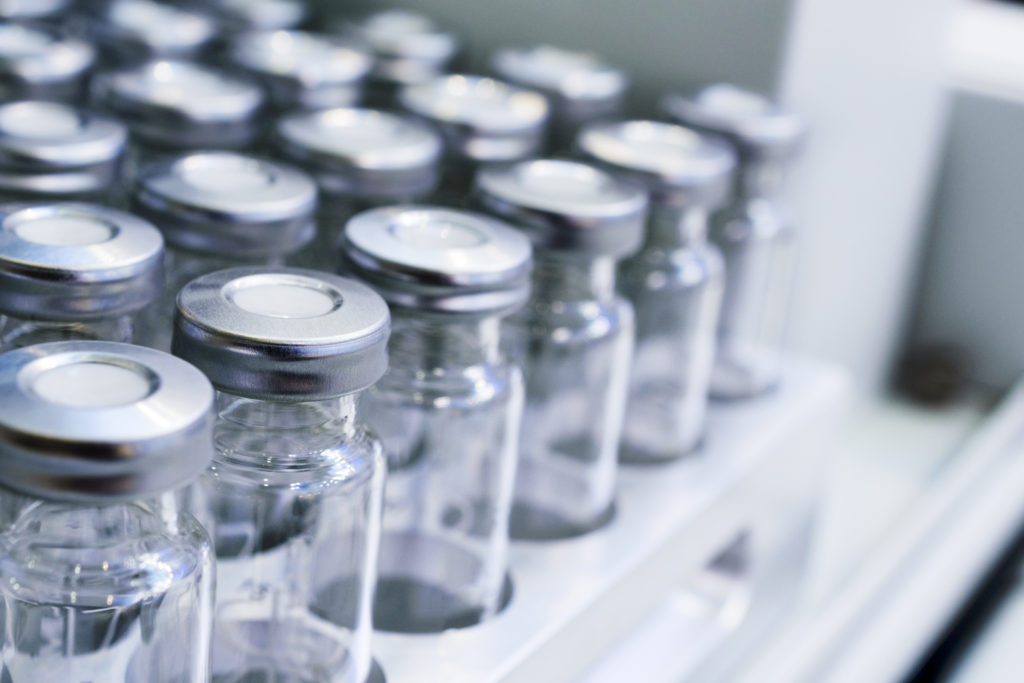To Issue 147
Citation: Polini E, “Mitigating Container Closure Integrity Challenges for Injectables.” ONdrugDelivery, Issue 147 (May 2023), pp 58–60.
Based on an article also published in Express Pharma, May 2023.
Eugene Polini discusses the importance of container closure for the parenteral drug market, including some of the consequences of compromised container closure and what steps manufacturers can take to ensure that primary packaging systems remain sealed for a product’s entire shelf life.
PRIMUM NON NOCERE
“Injectable therapies are often highly sensitive drugs and require the most rigorous protective measures to ensure that unwanted particles, microbes and oxidants do not jeopardise formulation integrity.”
“First, do no harm”, the Hippocratic Injunction, is the often-official motto of healthcare providers, organisations and associations around the world and sets the bar for the global pharmaceutical industry. Patient safety should always come first. However, this philosophy is not just for guiding the practices of medical professionals and drug developers; it extends all the way down to the healthcare sector’s expectations for every component, instrument and process in the development and manufacture of medicine. Injectable therapies are often highly sensitive drugs and require the most rigorous protective measures to ensure that unwanted particles, microbes and oxidants do not jeopardise formulation integrity.
These high standards are not attainable without a serious commitment to container closure integrity (CCI). CCI is the ability of a container closure system to maintain the sterility of the pharmaceutical products contained therein throughout its shelf life. It is also a regulatory requirement for container closure designs. In the case of parenteral drugs, CCI aims to avoid adulteration of the drugs packaged in vials, syringes and cartridges (Figure 1). Even though these types of packaging systems are hermetically sealed, there are still many risks to mitigate.

Figure 1: Parenteral drugs packaged in vials.
WHY IS CCI CRITICAL?
CCI is subject to many threats from the ambient environment. When it comes to sterile packaging, standard industry preference is for a terminal sterilisation process, wherein the entire packaging system is sterilised at the end of production. Alternatively, drug manufacturers can package drugs with components that have been sterilised individually, then assembled and filled aseptically by filtering the drug product through a 0.2 μm filter. However, drugs filled and packaged using either method are still subject to the risks posed by CCI failure.
Loss of Aqueous Solvent
If the drug is in an aqueous medium, any hole in the vial can accelerate vaporisation, which can translate to a loss of solvent. Not only can this issue compromise the formulation and patient health, but the disappearance of a labelled ingredient can land drug manufacturers on the wrong side of the law; it is illegal to sell a mislabelled drug in most countries around the world.
Oxidation
Oxygen is, obviously, a potent oxidiser and must be excluded from parenteral packaging systems. Otherwise, the presence of oxygen can lead to the breakdown of fats, lipids, proteins and other ingredients, compromising the drug formulation and its therapeutic impact. In a 5 mL vial, there is typically 3 mL of liquid drug product and 2 mL of gas sitting above it. Therefore, drug manufacturers typically fill the excess space with either nitrogen or argon to exclude any oxygen from the system.
A leak would cause equilibration between the contents of the container and the outside environment. The oxygen-rich environment outside the vial will seep into the vial interior and equilibrate so the atmosphere is 18% oxygen both outside and inside the vial at the same barometric pressure. This can lead to oxidation of the API and inhibit the therapeutic efficacy of the dose.
Introduction of Microbes
A leak in a vial can let in more than just oxygen. There is also the threat of intrusion by microbes, which can be highly dangerous, depending on the microbe and the condition of the patient’s immune system. Even the pressure change of a storm could create the conditions not only to pull out, but also to push in material if there is a leak.
“It must be remembered that every small component, such as stoppers, plungers and caps, has a critical role to play in preserving CCI as part of the parenteral drug packaging system.”
WHAT CAN DRUG MANUFACTURERS DO TO MINIMISE THESE RISKS?
First, it must be remembered that every small component, such as stoppers, plungers and caps, has a critical role to play in preserving CCI as part of the parenteral drug packaging system (Figure 2). Stoppers are placed at the top of syringes, vials and cartridges to seal the barrels of these containers. Plungers glide through the barrel of syringes to deliver injectable drugs smoothly and effectively. Caps often top off vials and are comprised of both metal and rubber components. All must be designed with painstaking care to ensure compatibility with the drug product they interact with. With those in place, there are many assessments, practices and technologies available to help drug manufacturers enhance CCI.

Figure 2: Every small component of a primary packaging system, stoppers, plungers and caps alike, has a critical role to play in preserving drug integrity.
Paper Analysis
In this process, analysts compare drawings of components to drawings of the vials and syringe barrels to ensure that there is enough compression and interference between the elastomer and the glass or plastic package to create a seal. Furthermore, they check to make sure there is not too much interference or compression, which can compromise machinability during assembly. For syringes, they must also check break-loose and glide forces for the same factors. The fit should not be too tight or too loose; it must be just right. Typically, the target is approximately 2% compression between the rubber and the walls of the package, but optimal results may vary. For a stopper, more compression is desirable, whereas a plunger requires less to ensure mobility up and down the barrel of the vial.
“No matter where drugs are manufactured, pharmaceutical companies are still subject to the CCI standards of the markets they serve.”
Many vials are now made with blowback features – small, recessed rings inside the neck of the vial – that allow the rubber to relax into them, which helps to prevent back pressure popping the stopper off. A matching feature can be added to the stopper, such as a protuberance that is designed to snag into the recess. However, problems can arise when the blowback feature is mismatched with the stopper design, so these features must be carefully considered and tolerances included. More recently, there was a movement to make blowback tolerances and dimensioning for these features clearer at the specification stage, which would enable drug manufacturers to better identify potential mismatches during paper analysis.
Dry Lab Work
Dry lab, or exploratory developmental, work consists of a series of practical physical tests. The pop-up test is one example; a vial is filled with water and a stopper is placed loosely on top. This system is then frozen, after which the stopper is inserted to observe whether it pops out due to positive pressure as the system thaws. The cold gas in the headspace after sealing starts to warm up, increasing the pressure and potentially popping the stopper off. This test is an effective way to assess for stopper and vial compatibility.
CCI Testing
Following dry lab work, the system’s CCI is tested with more advanced instrumentation. Typically, these tests use the final drug product, minus the API, to ensure that the package is robust and shows no leakage over the temperature range that the drug product will experience through its lifecycle. This may include cold-chain testing for cryogenic or cold storage, which is often a challenging barrier to success due to the effect of extreme cold on elastomeric components. For example, some drugs must stay at liquid nitrogen temperature (-185°C) to maintain viability. However, rubber and plastic materials take on the attributes of glass at those temperatures, making it difficult to achieve an adequate seal, and requiring alternative approaches.
Residual Seal Force Testing
Residual Seal Force Testing can help elucidate the residual spring left in the elastomeric closure’s flange. The flange compresses as vertical force is applied during capping. By locking the skirt in a metal furl during sealing, the energy in the rubber flange is captured and keeps the rubber in a state of compression, which aids in keeping the system sealed throughout the product’s lifespan. Measuring residual seal force can test if the capping force is too great, which may create a wrinkle or fold and, ultimately, a product leak. This testing can help drug manufacturers find the sweet spot for capping force as a measure to maximise seal integrity.
Shelf Studies
Shelf studies occur after the drug product is manufactured and include repetitive CCI testing at frequent intervals throughout its proposed shelf life. Typically, the manufacturer will put up three lots of drug product in its packaging. Then, at periods of 0, 1, 2, 3, 6, 12 and 18 months, these samples are tested for, among other things, the quality of their CCI. This assessment gives drug manufacturers a good idea of how the drug will fare over time in storage.
INTERNATIONAL CONSIDERATIONS
No matter where drugs are manufactured, pharmaceutical companies are still subject to the CCI standards of the markets they serve. This can complicate the manufacturing process, as pharmacopoeias vary by region. For example, Japan has extremely strict regulations around sterility for closures compared with other markets, requiring significant R&D efforts to develop elastomeric closures that met the standard.
As another example, The US FDA prefers deterministic CCI testing over the probabilistic CCI testing of the past. This preference is due to the fact that probabilistic methods are more subjective and contain more qualitative methodology, whereas deterministic methods are quantitative and non-destructive while still providing actionable insights. As a result, there is greater certainty with deterministic testing methodologies.
As such, it is critical that drug manufacturers comprehend the differences between the markets they serve and work closely with suppliers that understand the nuances of different regional regulations.

